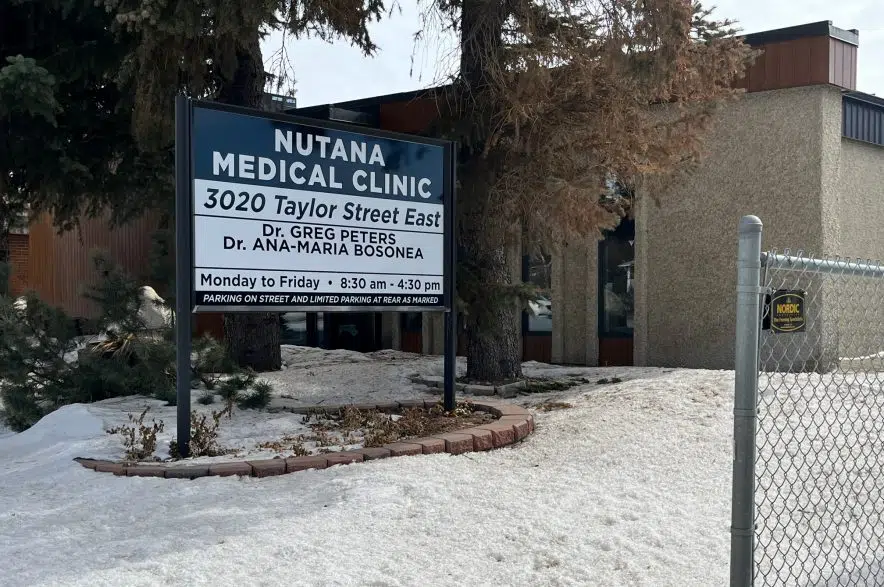Spring is allergy season, but if a child under 12 in Saskatoon needs to see an allergist they may have to leave the province to do it.
Dr. Ana-Maria Bosonea is the only allergist in Saskatoon who currently treats children under age 12. She’s trained to see both adults and children, but when her predecessor and mentor, Dr. Mitra Persaud, retired, Bosonia said she narrowed the scope of her practice to young children just to meet the high demand.
Bosonea, who is pregnant with twins, abruptly had to stop seeing patients due to complications with her pregnancy.
One other allergist, Dr. Greg Peters, sees young people in Saskatoon, but his practice focuses on patients who are 12 and older.
When Persaud retired, Bosonea said the demand was immense and suddenly fell completely on her shoulders.
“It’s zero to 100,” she said.
So many families need her services that Bosonea said she stopped keeping a waiting list when it reached three years.
“It’s very overwhelming,” Bosonea said. “It’s been kind of hard to know what the realistic waitlist is.”
She said part of that is due to the waitlist constantly changing, with some families being pushed back to accommodate and prioritize children with more urgent needs, like food allergies, which could lead to severe reactions and hospitalization.
Bosonea treats issues like seasonal, food and insect allergies as well as immunology issues like immunodeficiencies and eczema.
As the only pediatric allergist receiving referrals in Saskatoon, Bosonea said she also inherited an entire catalogue of patients — about 200 waiting on top of new referrals — from her predecessor.
“It’s hard when you’re by yourself, because it’s a lot of responsibility,” she explained. “There’s no backup.”
Gap in service
Bosonea said she knew she’d have to step back from her job for a time to take on her new role as a mom. However, she expected to have another several months before that became a reality. Complications with her pregnancy shortened that timeline.
“My plans were kind of derailed,” she said.
The allergist said she’s not able to physically practice until after the birth of her twins.
Currently, two allergists in Regina can see pediatric patients, although both have waitlists. For patients who can’t wait, Bosonea said she is offering referrals out of the province, but knows it isn’t fair for families to have to travel for hours Winnipeg, Edmonton or Calgary.
It’s stressful for her patients, Bosonea shared, and stressful for her as well. When her children are born, Bosonea said she’d also have to travel to see another pediatric allergist if her children require it.
At this point, Bosonea said she can’t say when she will return to her practice. Though she’d like to as soon as is feasible — ideally January of next year — she said substantial waitlists for child care could also delay her return.

Dr. Ana-Maria Bosonea, Saskatoon’s only pediatric allergist, is worried about the gap in service left behind while she is on maternity leave. (Ana-Maria Bosonea/Submitted)
Saskatchewan underserviced
With Saskatchewan having also recently lost its only pediatric gastroenterologist, Bosonea noted there are barriers standing in the way of attracting specialist physicians to the province.
“It’s just really hard to go into an under-serviced area knowing the pressure is on you,” Bosonea said.
She said she didn’t expect to be the only specialist of her kind in the city when she moved to Saskatoon.
The allergist left Edmonton in August after her husband, a cardiac surgeon, secured a job in Saskatoon. She said she’s glad they made the move, as they have family here to support them and she is enjoying life on the prairies.
However, Bosonea said her practice here has been different.
Edmonton has many more allergists working, serving both adults and children, so Bosonea previously had to advertise and build up a client list during her two years working there — a vastly different experience from the waitlist of patients clamouring to see her in Saskatchewan.
“You feel guilty not being able to see everyone, and there’s a lot of … anger and frustration from parents and patients that there’s nothing we can really do about,” she said.
As a result, Bosonea said she’s working longer hours and more days in Saskatoon than she was in Edmonton, but is earning the same income.
“I knew it was going to be a bit of a pay cut,” she shared. “I don’t think I knew it was going to be quite that drastic.”
She said she could make the same amount of money she is currently making in Saskatoon by working only 10 days a month in Edmonton.
Shortages persisting
Bosonea said she believes there are multiple factors at play behind the shortages of doctors and specialists in Saskatchewan.
Lower pay is one issue. Bosonea said provinces like Alberta and B.C. have been increasing rates to attract physicians. Manitoba pays higher rates than Saskatchewan for Bosonea’s specialty, she said, and the pay bump might be a draw to that province for allergists considering life on the prairies, she noted.
Bosonea said she had a physician from Ontario interested in securing a locum position, which would have allowed them to temporarily fill in for her for a period of time to treat patients referred for care.
However, upon seeing the pay rate they would receive, she said that doctor opted to work in Alberta for higher pay and additional supports. The specialist told Bosonea that they would be losing money by taking the position in Saskatoon.
Bosonea called it an “eye-opening” conversation.
“We need help,” she said. “I’m not sure what else to do.”
A lack of local training opportunities is also contributing to the shortage, Bosonea added.
“We don’t have anyone in Alberta or Saskatchewan that is training here and potentially staying here,” the allergist explained, noting that allergy training schools — and enough specialists to do that training — largely don’t exist in the prairies.
“I think what most of the public doesn’t realize is we spend a lot of time in school,” Bosonea stated.
Rattling off education requirements, Bosonea noted that three to four years in undergraduate studies, four years of medical school, a residency between two and six years and possibly further specialty training adds up to a significant amount of time, during which many medical students and graduates must move more than once.
She suggested more incentives — like hospital work or privileges for those interested, increasing fee rates or creating specific allergy rates for specialists — might help pique the interest of practicing allergists considering Saskatchewan.
Bosonea also recommended the province further promote its own attractions, small towns, friendly environment and benefits like low traffic and the reduced cost of living compared to bigger urban centres found elsewhere in Canada.
“It’s hard to kind of sway people to come to a place maybe they’ve never seen, they’ve never heard of … never had on their radar to live in,” she suggested.
Ultimately, however, Bosonea said the physician shortage gives power to physicians, who – with so many opportunities existing across Canada – can choose where they want to live and work.
“We’re in a crisis,” Bosonea said.
For now, the allergist said she plans to contact the Saskatchewan Medical Association to urge them to increase pay for her specialty and allocate funds for support staff in efforts to entice another specialist to the province, at least for the remainder of the year.
Otherwise, Bosonea is encouraging patients who are frustrated to bring their complaints to the Ministry of Health in an effort to get the government’s attention and fill the gap in care.











